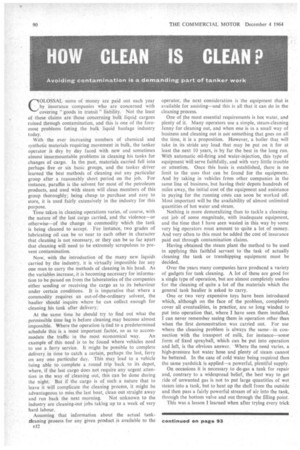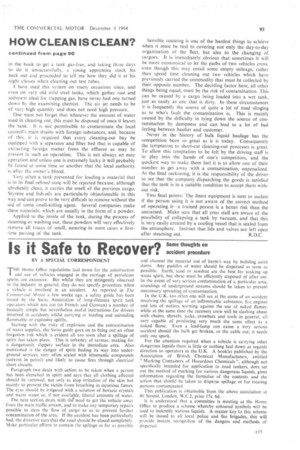HOW CLEAN
Page 92

Page 95

If you've noticed an error in this article please click here to report it so we can fix it.
Avoiding contamination is a demanding part of tanker work COLOSSAL sums of money are paid out each year by insurance companies who are concerned with covering "goods in transit" liability. Not the least
_ of these claims are those concerning bulk liquid cargoes ruined through contamination, and this is one of the foremost problems fating the bulk liquid haulage industry today.
With the ever increasing numbers of chemical and synthetic materials requiring movement in bulk, the tanker operator is day by day faced with new and sometimes almost insurmountable problems in cleaning his tanks for changes of cargo. In the past, materials carried fell into perhaps five or six basic groups, and the tanker driver learned the best methods of cleaning out any particular group after a reasonably short period on the job. For instance, paraffin is the solvent for most of the petroleum products, and used with steam will clean members of this group thoroughly; being cheap to purchase and easy to store, it is used fairly extensively in the industry for this purpose.
Time taken in cleaning operations varies, of course, with the nature of the last cargo carried, and the violence—or otherwise—of the change in commodity which the tank is being cleaned to accept. For instance, two grades of lubricating oil can be so near to each other in character that cleaning is not necessary, or they can be so far apart that cleaning will need to be extremely scrupulous to prevent contamination.
Now, with the introduction of the many new liquids carried by the industry, it is virtually impossible for any one man to carry the methods of cleaning in his head. As the variables increase, it is becoming necessary for information to be passed on from the laboratories of the companies either sending or receiving the cargo as to its behaviour under certain conditions. It is imperative that where a commodity requires an out-of-the-ordinary solvent, the haulier should inquire where he can collect enough for cleaning his tank after delivery.
At the same time he should try to find out what the permissible time lag is before cleaning. may become almost impossible. Where the operation is tied to a predetermined schedule this is a most important factor, so as to accom modate the traffic in the most economical way. An example of this need is to be found where vehicles need to use a ferry service. It might be possible to complete delivery in time to catch a certain, perhaps the last, ferry on any one particular day. This may lead to a vehicle being able to complete a round trip back to its depot, where, if the last cargo does not require any urgent attention in the way of cleaning out, this can be done during the night. But if the cargo is of such a nature that to leave it will complicate the cleaning process, it might be advantageous to miss the last boat, clean out straight away and run back the next morning. Not unknown to the industry are cleaning-out jobs taking up to a week of very hard labour.
Assuming that information about the actual tankcleaning proeess for any given product is available to the operator, the next consideration is the equipment that is available for assisting—and this is all that it can do in the cleaning process.
One of the most essential requirements is hot water, and plenty of it. Many operators use a simple, steam-cleaning Jenny for cleaning out, and when one is in a small way of business and cleaning out is not something that goes on all the time, it is a proposition. However, a boiler that will take in its stride any load that may be put on it for at least the next 10 years, is by far the best in the long run. With automatic oil-firing and water-injection, this type of equipment will serve faithfully, and with very litttle trouble or attention. Once this basis is established, there is no limit to the uses that can be found for the equipment. And by taking in vehicles from other companies in the same line of business, but having their depots hundreds of miles away, the initial cost of the equipment and assistance in paying for the running costs can soon be worked off. Most important will be the availability of almost unlimited quantities of hot water and steam.
Nothing is more demoralizing than to tackle a cleaningout job of some magnitude, with inadequate equipment, and the time that I have seen wasted in this way by some very big operators must amount to quite a lot of money. And very often to this must be added the cost of insurance paid out through contamination claims.
Having obtained the steam plant the method to be used in applying this faithful servant to the task of actually cleaning the tank or transhipping equipment must be decided.
Over the years many companies have produced a variety of gadgets for tank cleaning. A lot of these are good for a single type of operation, but are almost completely useless for the cleaning of quite a lot of the materials which the general tank haulier is asked to carry.
One or two very expensive toys have been introduced which, although on the face of the problem, completely cover all eventualities, in practice, are so long winded to put into operation that, where I have seen them installed, I can never remember seeing them in operation other than when the first demonstration was carried out. For use where the cleaning problem is always the same—in connection with the transport of milk, for instance—some form of fixed sprayball, which can be put into operation and left, is the obvious answer. Where the need varies, a high-pressure hot water hose and plenty of steam cannot be bettered. In the case of cold water being required then the same yardstick is applied—a powerful, plentiful supply.
On occasions it is necessary to de-gas a tank for repair and, contrary to a widespread belief, the best way to get ride of unwanted gas is not to put large quantities of wet steam into a tank, but to heat up the shell from the outside and then pass a fairly powerful stream of air into the tank, through the bottom valve and out through the filling point.
This was a lesson I learned when after trying every trick in the book to get a tank gas-free, and taking three days to do it unsuccessfully, a young apprentice stuck his neck out and proceeded to tell me how they ,did it at his night classes when cleaning out test tubes.
I have used this system on many occasions since, and even on very old mild steel tanks, which gather rust and sediment ideal for trapping gas, have never had one turned down by the examining chemist. The air jet needs to be of very high quantity and does not need high pressure.
One must not forget that whatever the amount of water used in cleaning out, this must be disposed a once it leaves the tank. It is not permissible to contaminate the local council's main drains with foreign substances, and, because of this, it is required that every cleaning-out bay be equipped with a separator and filter bed that is capable of extracting foreign matter from the effluent as may be present in such an operation. This is not always an easy operation and unless one is extremely lucky it will probably he found at some time or another that the local authority is after the owner's blood.
Very often a tank presented for loading a material that is in its final refined state will be rejected beeause, although absolutely clean, it carries the smell of the previous cargo. Styrene and fish-oils are particularly objectionable in this way and can prove to be very difficult to remove without the aid" of some smell-killing agent. Several companies make these materials, which are usually in the form of a powder.
Applied to the inside of the tank, during the process of steaming or washing Out, these powders will very effectively remove all traces of smell, assuring in most cases a firsttime passing of the tank. Sensible routeing is one of the hardest things to achieve when it must be tied to covering not only the day-to-day organization of the fleet, but also to the changing of cargoes. It is immediately obvious that sometimes it will be more economical to let the paths of two vehicles cross, even though this may entail some empty mileage, rather than spend time cleaning out two vehicles which have previously carried the commodity that must be collected by their opposite number. The deciding factor here, all other things being equal, must be the risk of contamination. This can be caused by a cargo being loaded into a wet tank, just as easily as one that is dirty. In these circumstances it is frequently the source of quite a lot of mud slinging as to who's fault the contamination is. This is mainly caused by the difficulty in tying down the source of contamination by dampness and can lead to a lot of bad feeling between haulier and customer.
Never in the history of bulk liquid haulage has the competition been so great as it is today. Consequently the temptation to short-cut cleaning-out processes is great. To allow this temptation to be felt by the driving staff is to play into the hands of one's competitors, and the quickest way to make them feel it is to allow one of their number to get away with a contamination, unpenalized. At the final reckoning, it is the responsibility of the driver to see that the company dispatching the goods is satisfied that the tank is in a suitable condition to accept them without risk.
Two final points: The finest equipment is next to useless if the person using it is not aware of the correct method of operating it—a trained person is a better risk than the untrained. Make sure that all your staff are aware of the possibility of collapsing a tank by vacuum, and that this 'is very easily created by a cooling vessel that is seated from the atmosphere. Instruct that /ids and valves are left open
after steaming out. R.D.C.
































































































































































































